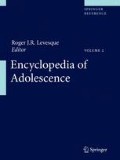Access this chapter
Tax calculation will be finalised at checkout
Purchases are for personal use only
References
Agnew, R. S. (1992). Foundation for a general strain theory of crime and delinquency. Criminology, 30, 47–87.
Ajzen, I. (1985). From decisions to actions: A theory of planned behavior. In J. Kuhl & J. Beckmann (Eds.), Action-control: From cognition to behavior (pp. 11–39). New York: Springer.
Ajzen, I. (1988). Attitudes, personality, and behavior. Homewood: Dorsey.
Ajzen, I. (1991). The theory of planned behavior. Organizational Behavior and Human Decision Processes, 50, 179–211.
Ajzen, I., & Fishbein, M. (1980). Understanding attitudes and predicting social behavior. Englewood Cliffs: Prentice Hall.
Akers, R. L. (1977). Deviant behavior: A social learning approach (2nd ed.). Belmont: Wadsworth.
American Lung Association. (2007). An emerging deadly trend: Waterpipe tobacco use. Washington, DC: American Association. http://pediatrics.aappublications.org/cgi/content/abstract. Accessed 21 October 2009.
Bandura, A. (1977). Self-efficacy: Toward a unifying theory of behavior change. Psychological Review, 84, 191–215.
Bandura, A. (1982). Self-efficacy mechanism in human agency. The American Psychologist, 37, 122–147.
Bandura, A. (1986). Social foundations of thoughts and action: A social cognitive theory. Englewood Cliffs: Prentice Hall.
Campaign for Tobacco-Free Kids. (2009). Smokeless tobacco and kids. Washington, DC: Campaign for Tobacco-Free Kids. http://tobaccofreekids.org/research/factsheets/pdf/0003.pdf. Accessed 21 Oct 2009.
Cancer Foundation. (2009). Types of tobacco use. http://www.cancer.org/downloads/AA/TobaccoAtlas01.pdf. Accessed 22 Jan 2010.
Catalano, R. F., & Hawkins, J. D. (1996). The social development model: A theory of antisocial behavior. In J. D. Hawkins (Ed.), Delinquency and crime: Current theories (pp. 149–197). New York: Cambridge University Press.
Centers for Disease Control and Prevention. (1994). Preventing tobacco use among young people: A Report of the Surgeon General. Atlanta: U.S. Department of Health and Human Services.
Centers for Disease Control and Prevention. (1996). Tobacco use and usual source of cigarettes among high school students – United States – 1995. Morbidity and Mortality Weekly Report, 45, 413–418. Oral Cancer Foundation (2009). Types of tobacco. oralcancerfoundation.org/tobacco/types_of_Tobacco.htm. Accessed 21 Oct 2009.
Centers for Disease Control and Prevention. (1999). Bidi use among urban youth – Massachusetts, March–April 1999. Morbidity and Mortality Weekly Report, 48, 796–799.
Centers for Disease Control and Prevention. (2008). Youth risk behavior surveillance – United States, 2007. Morbidity and Mortality Surveillance Summary, 57 (4), 1–131.
Centers for Disease Control and Prevention. (2009). Smoking and tobacco use fact sheet. Atlanta: Office on Smoking and Health, National Center for Chronic Disease Prevention and Health Promotion. Retrieved October 21, 2009 from http://www.cdc.gov/tobacco/data_statistics/fact_sheets.
Delnevo, C. D., Pevzner, E. S., Hrywna, M., & Lewis, M. J. (2004). Bidi cigarette use among young adults in 15 states. Preventative Medicine, 39, 207–211.
Elliott, D. S., Huizinga, D., & Ageton, S. S. (1985). Explaining delinquency and drug use. Beverly Hills: Sage.
Elliott, D. S., Huizinga, D., & Ageton, S. S. (1989). Multiple problems youth: Delinquency, substance use, and mental health problems. New York: Springer-Verlag.
Erikson, E. H. (1950). Childhood and society. New York: W. W. Norton.
Hawkins, J. D., & Weiss, J. G. (1985). The social development model: An integrated approach to delinquency prevention. Journal of Primary Prevention, 6, 73–97.
Hirschi, T. (1969). Causes of delinquency. Berkeley: University of California Press.
Khantzian, E. J. (1985). The self-medication hypothesis of addictive disorders: Focus on heroin and cocaine dependence. The American Journal of Psychiatry, 142, 1259–1264.
Merton, R. K. (1968). Social theory and social structure. New York: Free Press.
National Cancer Institute. (1992). Smokeless tobacco or health: An international perspective. Bethesda: U. S. Department of Health and Human Services, National Institute of Health, National Cancer Institute. http://cancercontrol.cancer.gov/tcrb/monographs. Accessed 22 January 2010.
Oral Cancer Foundation. (2009). Types of tobacco. oralcancerfoundation.org/tobacco/types_of_Tobacco.htm. Accessed 21 Oct 2009.
Petraitis, J., Flay, B. R., & Miller, T. Q. (1995). Reviewing theories of adolescent substance use: Organizing pieces of the puzzle. Psychological Bulletin, 117 (1), 67–86.
Reckless, W. C. (1961). A new theory of delinquency and crime. Federal Probation, 25, 42–46.
Substance Abuse and Mental Health Services Administration, Office of Applied Studies. (1999). The relationship between mental health and substance abuse among adolescents. OAS Analytic Series #9 (DHHS Publication No. SMA 99–3286). Rockville: Author.
Substance Abuse and Mental Health Services Administration. (2009). Results from the 2008 National Survey on Drug Use and Health. Rockville, MD: Office of Applied Studies, Author.
Substance Abuse and Mental Health Services Administration, Office of Applied Studies. (2007). The OAS report: A day in the life of American adolescents: Substance use facts. Rockville: Author.
U.S. Department of Health and Human Services. (1994). Preventing tobacco use among young people: A Report of the Surgeon General. Atlanta: U.S. Department of Health and Human Services, National Center for Chronic Disease Prevention, Office of Smoking and Health.
U.S. Department of Health and Human Services. (2000). Reducing tobacco use: A Report of the Surgeon General. Atlanta: U.S. Department of Health and Human Services, Centers for Disease Control and Prevention, National Center for Chronic Disease Prevention and Health Promotion, office on Smoking and Health.
World Health Organization. (2006). Tobacco: Deadly in any form or disguise. http://www.who.int/tobacco/communications/events. Accessed 21 Oct 2009.
World Health Organization. (2007). Smokeless tobacco and some tobacco-specific nitrosamines. International agency for research on cancer monographs on the evaluation of carcinogenic risks to humans, vol. 89, Lyon, France. http://monographs.iarc.fr/ENG/Monographs/vol89/mono89.pdf. Accessed 21 Oct 2009.
Author information
Authors and Affiliations
Corresponding author
Editor information
Editors and Affiliations
Rights and permissions
Copyright information
© 2011 Springer Science+Business Media, LLC
About this entry
Cite this entry
Morris, S.V.C. (2011). Tobacco Use. In: Levesque, R.J.R. (eds) Encyclopedia of Adolescence. Springer, New York, NY. https://doi.org/10.1007/978-1-4419-1695-2_275
Download citation
DOI: https://doi.org/10.1007/978-1-4419-1695-2_275
Published:
Publisher Name: Springer, New York, NY
Print ISBN: 978-1-4419-1694-5
Online ISBN: 978-1-4419-1695-2
eBook Packages: Behavioral Science

